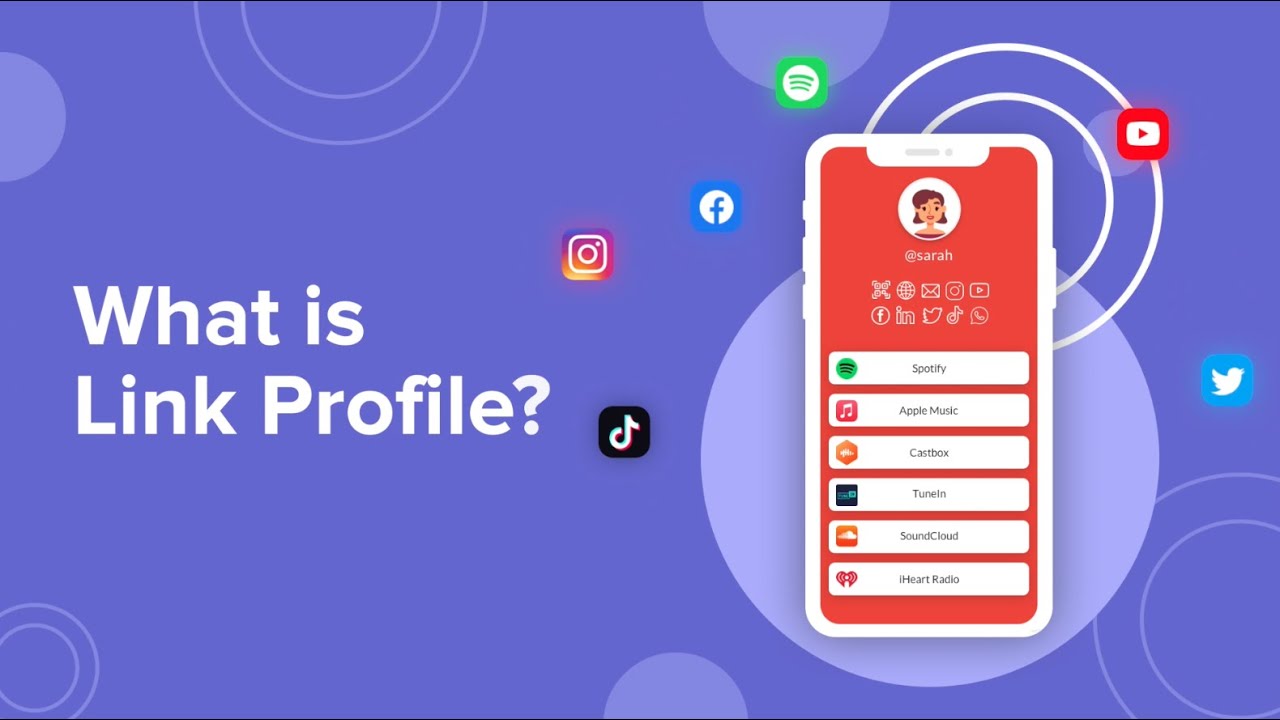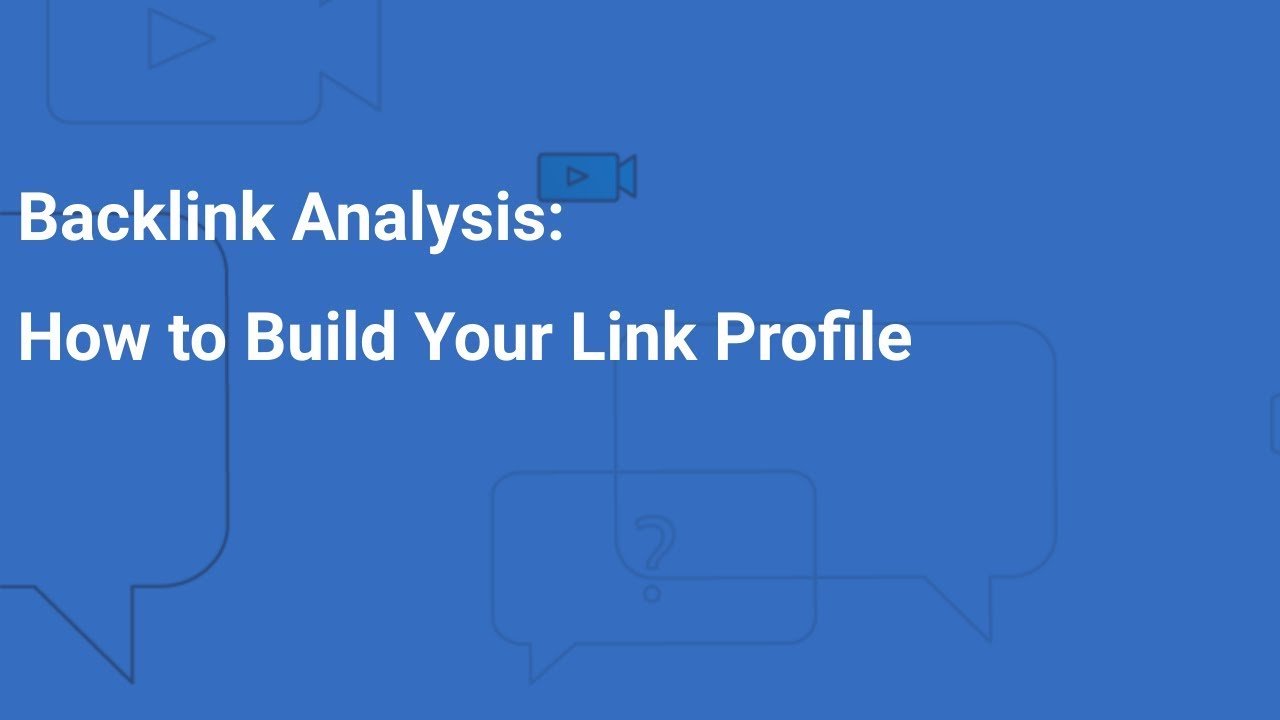In the vast digital landscape of the internet, link profile SEOhas emerged as a crucial component of effective search engine optimizationstrategies. A link profile refers to the collection of inbound links pointing to a website from external sources. These links serve as indicators of a website's credibility, relevance, and popularity, influencing its rankings on search engineresult pages.
Link profile SEOinvolves the deliberate cultivation of a strong and authoritative link profile to enhance a website's visibility, organic traffic, and overall online presence. In this article, we will explore the significance of link profile SEOand discuss strategies to build a solid link profile that can drive success in the competitive online world.
What Is A Link Profile In SEO?

What is Link Profile?
In SEO, a link profile refers to the collection of inbound links that point to a particular website. It encompasses all the links coming from external sources to that website's pages. These external links, also known as backlinks, are considered by search engines as indicators of a website's credibility, relevance, and popularity. The link profile of a website is evaluated based on factors such as the quality, quantity, and diversity of the backlinks.
A strong link profile with high-quality and relevant backlinks can positively influence a website's search engine rankings, organic visibility, and overall online authority. On the other hand, a weak or spammy link profile can have a detrimental impact on a website's SEO performance. Therefore, managing and improving the link profile is an essential aspect of an effective SEO strategy.
Why Link Profile SEO Matters?
Link Profile SEO matters for several important reasons. Let's explore them in detail:
- Search Engine Rankings -Search engines consider the link profile of a website as a crucial ranking factor. A strong link profile with high-quality and relevant backlinks signals to search engines that your website is reputable, trustworthy, and valuable. It increases the likelihood of your website ranking higher in search engine result pages (SERPs) for relevant keywords and queries.
- Website Authority -A robust link profile enhances your website's authority within your industry or niche. When other reputable websites link to your content, it demonstrates that your website is a reliable and credible source of information. This authority not only improves your search engine rankings but also boosts user trust and confidence in your website.
- Relevance and Context -Inbound links provide contextual information about your website's content. When other websites link to your pages using relevant anchor text, it helps search engines understand the topics and themes associated with your website. This relevance and context contribute to improved visibility for specific keywords and search queries.
- Organic Traffic and Referral Visitors -A strong link profile can generate organic traffic from search engines. When your website ranks higher in SERPs, it attracts more clicks and visits from users actively searching for information related to your content. Additionally, backlinks from other websites act as pathways for referral visitors, driving traffic from those websites directly to yours.
- Brand Visibility and Awareness -Building a strong link profile involves obtaining links from various authoritative sources, including industry publications, influencers, and reputable websites. This exposure not only improves your website's visibility in search results but also increases brand awareness among your target audience. When users come across your links on reputable websites, it fosters brand recognition and can lead to further engagement and conversions.
- Long-Term SEO Success -Link profile SEO is a long-term strategy that yields sustainable results. Unlike certain short-term SEO tactics, a strong link profile is built on genuine endorsements and valuable content. By consistently focusing on building and maintaining a quality link profile, you create a foundation for long-term SEO success, which can withstand algorithm updates and changes.
Building A Solid Link Profile

Backlink Analysis: How to Build Your Link Profile
Building a solid link profile is essential for improving your website's authority, visibility, and search engine rankings. Here are some key strategies to help you build a strong link profile:
- Create High-Quality Content -Producing valuable, informative, and shareable content is the foundation of a strong link profile. When you consistently publish high-quality articles, blog posts, videos, or infographics, other websites are more likely to link to your content as a valuable resource.
- Guest Blogging -Guest blogging involves writing and publishing articles on other websites within your industry or niche. This strategy allows you to showcase your expertise, reach a new audience, and earn backlinks in return. Look for reputable websites with high domain authorityand engage in guest blogging opportunities to expand your link profile.
- Influencer Outreach -Identify influencers or thought leaders in your industry and establish relationships with them. Collaborate with influencers through interviews, expert roundups, or content contributions, which can result in valuable backlinks from their websites and social mediaplatforms.
- Broken Link Building-Broken link building is an effective technique that involves finding broken links on other websites and suggesting your content as a replacement. Use tools like Check My Links or Broken Link Checker to identify broken links in your niche. Reach out to website owners or webmasters, inform them about the broken link, and offer your relevant content as a suitable replacement.
- Social Media Promotion -Leverage social media platforms to promote your content and attract attention from potential link sources. Engage with your audience, share your articles, infographics, or videos, and encourage social sharing. When your content gains traction on social media, it increases the likelihood of others linking to it from their websites or blogs.
- Monitor and Disavow Toxic Links -Regularly monitor your link profile to identify potentially harmful or low-quality links pointing to your website. Tools like Google Search Console, Moz, or Ahrefs can help you analyze your backlink profile and identify suspicious links. If you find spammy or irrelevant links that may harm your SEO efforts, consider disavowing them through the Google Disavow Tool.
Remember, building a solid link profile takes time, effort, and a strategic approach. By implementing these strategies consistently, you can strengthen your link profile, enhance your website's authority, and improve your overall SEO performance.
Analyzing And Monitoring Your Link Profile

Understanding Your Link Profile: Four Link Profile Elements To Monitor
Analyzing and monitoring your link profile is an important aspect of maintaining a healthy and effective SEO strategy. Here are some key steps to analyze and monitor your link profile:
- Utilize SEO Tools -Take advantage of SEO tools like Google Search Console, Moz, Ahrefs, SEMrush, or Majestic to gather data about your backlinks. These tools provide insights into the number of backlinks, referring domains, anchor text, and other relevant metrics.
- Assess Link Quality -Evaluate the quality of your backlinks. Look for links from authoritative and relevant websites within your industry or niche. Consider factors such as domain authority, page authority, relevance to your content, and the reputation of the linking domain.
- Identify Toxic or Spammy Links -Identify any toxic or spammy links that may negatively impact your link profile. Look for links from low-quality websites, directories, or link farms. Pay attention to any links with unnatural anchor text or links from irrelevant sources.
- Monitor Link Growth -Keep track of your link growth over time. Monitor the acquisition of new backlinks and observe any significant changes or spikes. Evaluate the effectiveness of your link-building efforts and identify trends or patterns in your link acquisition strategy.
- Competitor Link Analysis -Analyze the backlink profiles of your competitors to gain insights and identify potential opportunities. Look for authoritative websites that are linking to your competitors and assess whether you can secure similar backlinks. This analysis can help you understand the link landscape within your industry.
- Track Anchor Text Diversity -Check the diversity of anchor text used in your backlinks. Ensure that your anchor text is varied and not overly focused on specific keywords. Natural and diverse anchor text usage appears more organic to search engines.
- Regular Auditing -Conduct regular audits of your link profile to identify any changes or issues. Perform periodic checks to ensure that your backlinks remain relevant, high-quality, and aligned with your SEO goals.
- Disavow Toxic Links -If you identify toxic or spammy links during your analysis, consider disavowing them. Use the Google Disavow Tool to inform search engines that you do not want these links to be considered when evaluating your website's authority.
Strategies For Enhancing Your Link Profile
To enhance your link profile and strengthen your website's authority and visibility, consider implementing the following strategies:
- Earned Link Building -Focus on creating high-quality, valuable content that naturally attracts backlinks. Develop informative articles, research studies, infographics, or videos that provide unique insights and solutions to your target audience's needs. When your content is genuinely useful and engaging, other websites are more likely to link to it organically.
- Link Profile Diversity -Aim for a diverse range of backlinks from various sources. Seek links from different types of websites such as industry blogs, news publications, forums, social media platforms, and authoritative directories. A diverse link profile signals to search engines that your website is relevant and valued across multiple platforms.
- Anchor Text Optimization -Optimize the anchor text of your backlinks to ensure they are descriptive and relevant to the linked page's content. Avoid excessive use of exact-match keywords in the anchor text, as it can be seen as manipulative. Instead, focus on natural and contextual anchor text that provides meaningful information to users and search engines.
- Outreach and Networking -Actively reach out to relevant websites, bloggers, and influencers in your industry. Build relationships and offer them valuable content or resources that they might be interested in sharing or linking to. Personalized and genuine outreach can lead to opportunities for guest blogging, collaborations, or obtaining editorial links.
- Content Marketingand Promotion -Develop a content marketing strategy to promote your high-quality content and attract backlinks. Share your content on social media platforms, engage with your audience, and encourage social sharing. Leverage email marketingcampaigns, influencer partnerships, and online communities to expand your content's reach and increase its chances of earning backlinks.
- Monitor and Disavow Toxic Links -Regularly monitor your link profile using tools like Google Search Console, Moz, or Ahrefs. Identify any low-quality or spammy links that may negatively impact your link profile and SEO performance. Consider disavowing these toxic links using the Google Disavow Tool to inform search engines not to consider them in their evaluation of your website.
- Stay Updated with Link Profile Best Practices -Keep abreast of the latest SEO trends, algorithm updates, and best practices for link building. Search engine guidelines and strategies evolve over time, so it's essential to adapt your link-building techniques accordingly to ensure long-term success.
Link Profile Maintenance And Growth
Link profile maintenance and growth are crucial to ensure the continued strength and effectiveness of your link profile. Here are some strategies to maintain and grow your link profile:
- Regular Backlink Auditing -Conduct regular audits of your backlink profile to identify any low-quality or toxic links that may have a negative impact on your SEO. Use tools like Google Search Console, Moz, or Ahrefs to analyze your backlinks and assess their quality, relevance, and potential risks.
- Disavow Toxic Links -If you discover any toxic or spammy links during your audit, consider disavowing them. The disavow process involves informing search engines not to consider those specific links when evaluating your website's authority. Use the Google Disavow Tool to submit a list of links you want to disavow and keep your link profile clean and healthy.
- Monitor Link Growth and Acquisition - Keep track of your link growth over time. Monitor new backlinks that are acquired naturally and ensure they are from reputable and relevant sources. Additionally, track your link acquisition efforts, such as guest blogging, influencer collaborations, or content promotion, to gauge their effectiveness and adjust your strategies if needed.
- Competitor Link Analysis -Conduct a competitor link analysis to identify potential link opportunities that you might have missed. Analyze the backlink profiles of your competitors using SEO tools and identify authoritative websites that are linking to them. Consider reaching out to those websites and pitch your content or collaborations to secure similar backlinks.
- Content Refresh and Promotion -Regularly update and refresh your existing content to keep it relevant and valuable. When you update your content, it presents an opportunity to reach out to websites that previously linked to your content and inform them about the updates. This can lead to additional backlinks or renewed promotion of your content.
- Building Relationships and Networking -Continue building relationships with influencers, bloggers, and industry experts. Attend conferences, webinars, or industry eventsto connect with like-minded individuals and explore potential collaboration opportunities. Building strong relationships can lead to more backlink opportunities and strengthen your link profile.
- Keep Up with SEO Trends -Stay updated with the latest SEO trends and best practices related to link building and link profile management. Search engine algorithms and guidelines evolve over time, so staying informed will help you adapt your strategies accordingly and maintain a competitive edge.
Examples Of Websites With Strong Link Profiles
Here are a few examples of websites known for having strong link profiles:
- Moz -Moz is a well-known provider of SEO software and resources. Their website has a strong link profile, with numerous high-quality backlinks from reputable sources in the SEO and digital marketing industry. Moz's extensive content, tools, and thought leadershiphave contributed to its authoritative link profile.
- Harvard University -Harvard University's website is an example of a strong link profile in the education sector. The university has a prestigious reputation, and its website has earned numerous high-quality backlinks from authoritative educational institutions, research papers, and media sources. This robust link profile reinforces Harvard's credibility and authority in academia.
- National Geographic -National Geographic is renowned for its exceptional photography and in-depth coverage of various subjects, including science, nature, and culture. Their website boasts a strong link profile with links from reputable sources such as scientific journals, travel blogs, and media outlets. The high-quality content and strong brand presence contribute to their authoritative link profile.
- BuzzFeed -BuzzFeed is a popular digital media company known for its entertaining and engaging content. Their website has a strong link profile with a diverse range of backlinks from various sources, including news publications, blogs, and social media platforms. BuzzFeed's viral content and extensive reach have contributed to its robust link profile.
- Wikipedia -Wikipedia is an online encyclopedia and a prime example of a website with a strong link profile. It has an extensive network of backlinks from reputable sources, including educational institutions, research organizations, and news outlets. Wikipedia's reputation for providing reliable and well-referenced information has contributed to its authoritative link profile.
People Also Ask
How Can I Improve My Link Profile?
To improve your link profile, focus on creating high-quality content that naturally attracts inbound links from reputable websites. Engage in guest blogging, influencer outreach, and broken link-building strategies. Promote your content on social media platforms and monitor your backlink profile for any toxic links that may harm your SEO efforts.
Are All Inbound Links Beneficial For My Link Profile?
Not all inbound links are beneficial for your link profile. It's important to focus on acquiring high-quality links from authoritative and relevant sources. Low-quality links, such as those from spammy websites or unrelated niches, can have a negative impact on your link profile and SEO performance.
What Is The Difference Between A Natural And Unnatural Link Profile?
A natural link profile consists of links that are acquired organically through high-quality content and genuine endorsements from other websites. These links are earned naturally and are a result of valuable and relevant content. On the other hand, an unnatural link profile involves manipulative tactics, such as buying links or participating in link schemes, with the sole intention of boosting search engine rankings.
Can A Strong Link Profile Guarantee Higher Rankings In Search Results?
While a strong link profile is an important factor for search engine rankings, it doesn't guarantee top positions in search results on its own. Search engines consider numerous other factors, including content relevance, website structure, user experience, and more
Conclusion
Link profile SEO is an indispensable aspect of any comprehensive search engine optimization strategy. Through the strategies mentioned above, website owners and SEO practitioners can strengthen their link profiles and reap the benefits of improved organic traffic and higher search engine rankings. In a competitive online landscape, investing time and effort into link profile SEO is an investment that can yield substantial long-term rewards.


